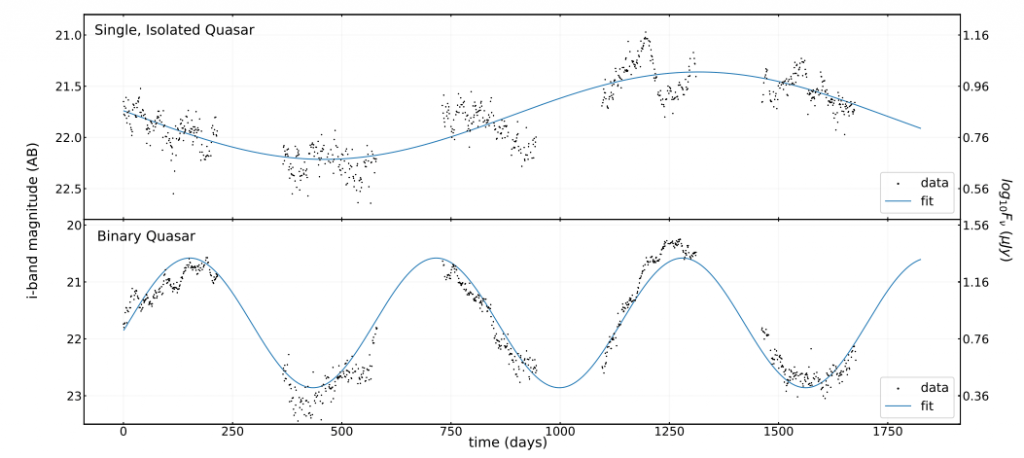When galaxies merge, we expect them to produce binary black holes (BBHs.) BBHs orbit one another closely, and when they merge, they produce gravitational waves that have been detected by LIGO-Virgo. The upcoming Vera Rubin Observatory should be able to find them before they merge, which would open a whole new window into the study of galaxy mergers, supermassive black holes, binary black holes, and gravitational waves.
As far as researchers can tell, large galaxies like ours have a supermassive black hole (SMBH) in their centers. When galaxies merge, the SMBHs enter into a close orbit with one another, becoming a binary black hole (BBH.) Eventually, they merge, and these mergers produce the most powerful gravitational waves.
The Vera Rubin Observatory (VRO) will perform a massive, multi-year time-domain survey that repeatedly images the sky looking for changes. It’s called the LSST: the Legacy Survey of Space and Time. It’ll detect everything from asteroids to supernovae explosions. But new research shows how the VRO can also detect binary black holes.

The new paper is titled “Reliable Identification of Binary Supermassive Black Holes from Rubin Observatory Time-Domain Monitoring.” It’s been submitted to The Astrophysical Journal and is currently in pre-print. The lead author is Megan Davis from the Department of Physics at the University of Connecticut.
“Periodic signatures in time-domain observations of quasars have been used to search for binary
supermassive black holes,” the authors write. The searches have produced several hundred candidate BBHs, but the problem is the high rate of false positives, as high as 60%. That’s way too high to produce useful data. Can researchers figure out how to get that rate down to something more manageable?
The authors say they’re making progress.
Quasars are a sub-class of active galactic nuclei (AGN) that are more luminous than other AGN. AGN are what we call SMBHs that are actively accreting material and emitting light. The problem is that quasars can be variable as they accrete material. That variability masks a BBH’s amplitude, leading to false positives. “Binary amplitude is overestimated and poorly recovered for two-thirds of potential binaries due to quasar accretion variability,” the authors write.

Modern astronomy is dominated by data, not observational skills. The researchers say the answer to the false positive problem lies in data and computation. “Rubin’s LSST, our best chance at identifying binary SMBHs with electromagnetic observations, also pushes us further into the era of big data, as it is predicted that it will produce over 20 terabytes of data per night,” the researchers write in their paper.
That huge amount of data means that the LSST will have to triage data as it arrives, and preparing an effective method for doing that in the search for BBHs starts with simulations. In this work, the researchers simulated millions of LSST Deep Field light curves for both single and binary quasars.
“Our goal is to create realistic light curves of quasars, both isolated (single-SMBH) and binary systems, for
Rubin’s LSST Deep Drilling Fields (DDFs),” the researchers write in their paper. DDFs are separate from the large survey the VRO will perform. They’re intense observations that provide deeper coverage and more frequent temporal sampling.
Quasars are complex objects, and the complexity increases when they’re binaries. Scientists think that both isolated and binary quasars have variable accretion disks. Binaries that are close to one another have a circumbinary accretion disk. But each individual SMBH has its own mini-disk, which complicates the picture. Generating realistic light curves for these different arrangements is the first step in the authors’ research.
“Our goal is to simulate light curves for a broad and representative range of the quasar population to be observed by Rubin,” the authors explain.

The researchers generated more than 3.6 million Rubin/LSST light curves from quasars, and a large number of them were for binary SMBHs. When examining and fitting all those curves, false positives remained a problem. “We conservatively estimate that over 40% of isolated, single quasars will result in a false positive detection of a binary SMBH system with a simple sinusoidal fit,” the authors write.
They also found that massive and luminous quasars are more likely to be a false positive than a real binary.
“We recommend exercising caution when using sinusoidal fits for binary SMBH detection,” the researchers conclude.
Differentiating between quasars and BBHs is not easy. Nature doesn’t hold up a sign telling us which is which. But nature does provide clues, though in this case, they’re entangled and difficult to discern. This work shows which type of quasar light curves are most likely to produce false positives, which is a big step toward dealing with the problem.
The researchers were also able to reduce false positives in some cases from around 60% down to around 40%. This is an important step in the right direction, though the problem still needs more work.
“The purpose of this paper was to explore the detectability of binary SMBHs for a representative quasar
population in Rubin/LSST DDF observations,” the authors explain. The next step is to use light curves generated not from simulations but from the observed population of quasars. Gravitational wave searches based on binary SMBHs will also be part of the effort.
Sinusoidal fits produce false positives, but there’s also another way of fitting the light curve data. It’s called DRW: Damped Random Walk. DRW is an economical computational method that could help manage the massive amount of data the Vera Rubin Observatory will produce. Davis and her colleagues intend to revisit their analysis with computationally inexpensive DRW fits in the future. “This
could result in a more effective triage of false positives,” they conclude.
In its ten-year run, the LSST is expected to detect between 20 million and 100 million active galactic nuclei. Determining which ones are BBHs means working through an enormous, unprecedented amount of data. If the LSST does produce 20 terabytes of data per night, then the task of working through all that data in search of BBHs takes on monumental proportions.
The researchers haven’t completely solved the two-headed problem of massive amounts of data and false positives populating the data, but they’ve made progress.

